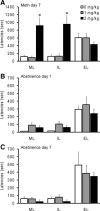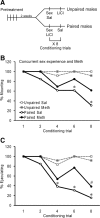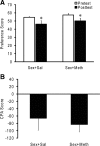Concurrent exposure to methamphetamine and sexual behavior enhances subsequent drug reward and causes compulsive sexual behavior in male rats
- PMID: 22072697
- PMCID: PMC6633219
- DOI: 10.1523/JNEUROSCI.4013-11.2011
Concurrent exposure to methamphetamine and sexual behavior enhances subsequent drug reward and causes compulsive sexual behavior in male rats
Abstract
Methamphetamine (Meth) users report having heightened sexual pleasure, numerous sexual partners, and engaging in unprotected sex due to loss of inhibitory control. This compulsive sexual behavior contributes to increased prevalence of sexually transmitted infections, but the neural basis for this is unknown. We previously established a paradigm for compulsive sexual behavior in male rats in which visceral illness induced by lithium chloride was paired with sexual behavior (Davis et al., 2010; Frohmader et al., 2010a). The current study examined the effects of repeated Meth administration on sexual performance, compulsive sexual behavior, and sex or Meth reward. First, results demonstrated that seven daily administrations of 2 mg/kg, but not 1 mg/kg, Meth increased latencies to initiate mating. This impairment was evident 30 min after last Meth administration, but dissipated after 1 or 7 d of subsequent drug abstinence. Repeated 1 mg/kg Meth exposure resulted in compulsive sex-seeking behavior 2 weeks following last Meth administration. This effect was dependent on Meth administration being concurrent with sexual experience and was not observed in sexually experienced animals that received Meth alone. Moreover, concurrent Meth and sexual experience enhanced conditioned place preference (CPP) for Meth, and for concurrent Meth and mating compared with Meth or mating alone. In contrast, CPP for mating alone was decreased. Together, these data indicate that the association between drug use and mating may be required for expression of compulsive sexual behavior and is correlated with increased reward seeking for concurrent Meth exposure and mating.
Figures








Similar articles
-
Maladaptive Sexual Behavior Following Concurrent Methamphetamine and Sexual Experience in Male Rats is Associated with Altered Neural Activity in Frontal Cortex.Neuropsychopharmacology. 2017 Sep;42(10):2011-2020. doi: 10.1038/npp.2017.1. Epub 2017 Jan 4. Neuropsychopharmacology. 2017. PMID: 28051103 Free PMC article.
-
Effects of methamphetamine on sexual performance and compulsive sex behavior in male rats.Psychopharmacology (Berl). 2010 Sep;212(1):93-104. doi: 10.1007/s00213-010-1930-8. Epub 2010 Jul 10. Psychopharmacology (Berl). 2010. PMID: 20623108
-
Reinstatement of methamphetamine conditioned place preference in nicotine-sensitized rats.Behav Brain Res. 2012 Dec 1;235(2):158-65. doi: 10.1016/j.bbr.2012.07.043. Epub 2012 Aug 4. Behav Brain Res. 2012. PMID: 22884606 Free PMC article.
-
Neural mechanisms underlying incubation of methamphetamine craving: A mini-review.Pharmacol Biochem Behav. 2020 Dec;199:173058. doi: 10.1016/j.pbb.2020.173058. Epub 2020 Oct 23. Pharmacol Biochem Behav. 2020. PMID: 33250444 Free PMC article. Review.
-
Sex differences in methamphetamine use disorder perused from pre-clinical and clinical studies: Potential therapeutic impacts.Neurosci Biobehav Rev. 2022 Jun;137:104674. doi: 10.1016/j.neubiorev.2022.104674. Epub 2022 Apr 20. Neurosci Biobehav Rev. 2022. PMID: 35452744 Free PMC article. Review.
Cited by
-
The Protective Effect of Social Reward on Opioid and Psychostimulant Reward and Relapse: Behavior, Pharmacology, and Brain Regions.J Neurosci. 2022 Dec 14;42(50):9298-9314. doi: 10.1523/JNEUROSCI.0931-22.2022. J Neurosci. 2022. PMID: 36517252 Free PMC article. Review.
-
Gender-specific differences in high-risk sexual behaviors among methamphetamine users in Myanmar-China border city, Muse, Myanmar: who is at risk?BMC Public Health. 2018 Feb 1;18(1):209. doi: 10.1186/s12889-018-5113-6. BMC Public Health. 2018. PMID: 29390989 Free PMC article.
-
Sexual behavior and testis morphology in the BACHD rat model.PLoS One. 2018 Jun 8;13(6):e0198338. doi: 10.1371/journal.pone.0198338. eCollection 2018. PLoS One. 2018. PMID: 29883458 Free PMC article.
-
Maladaptive Sexual Behavior Following Concurrent Methamphetamine and Sexual Experience in Male Rats is Associated with Altered Neural Activity in Frontal Cortex.Neuropsychopharmacology. 2017 Sep;42(10):2011-2020. doi: 10.1038/npp.2017.1. Epub 2017 Jan 4. Neuropsychopharmacology. 2017. PMID: 28051103 Free PMC article.
-
Methamphetamine-enhanced female sexual motivation is dependent on dopamine and progesterone signaling in the medial amygdala.Horm Behav. 2015 Jan;67:1-11. doi: 10.1016/j.yhbeh.2014.10.004. Epub 2014 Nov 11. Horm Behav. 2015. PMID: 25448531 Free PMC article.
References
-
- Agmo A. Copulation-contingent aversive conditioning and sexual incentive motivation in male rats: evidence for a two-stage process of sexual behavior. Physiol Behav. 2002;77:425–435. - PubMed
-
- Agmo A, Berenfeld R. Reinforcing properties of ejaculation in the male rat: role of opioids and dopamine. Behav Neurosci. 1990;104:177–182. - PubMed
-
- Bancroft J. Sexual behavior that is “out of control”: a theoretical conceptual approach. Psychiatr Clin North Am. 2008;31:593–601. - PubMed
-
- Belcher AM, Feinstein EM, O'Dell SJ, Marshall JF. Methamphetamine influences on recognition memory: comparison of escalating and single-day dosing regimens. Neuropsychopharmacology. 2008;33:1453–1463. - PubMed
Publication types
MeSH terms
Substances
Grants and funding
LinkOut - more resources
Full Text Sources
Medical
